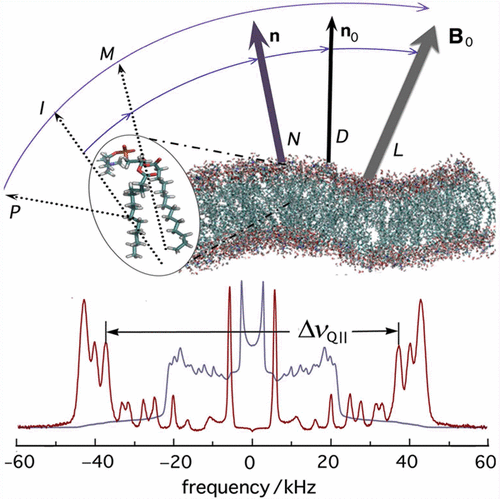当前位置:
X-MOL 学术
›
Chem. Rev.
›
论文详情
Our official English website, www.x-mol.net, welcomes your
feedback! (Note: you will need to create a separate account there.)
Concepts and Methods of Solid-State NMR Spectroscopy Applied to Biomembranes
Chemical Reviews ( IF 51.4 ) Pub Date : 2017-09-14 00:00:00 , DOI: 10.1021/acs.chemrev.6b00619 Trivikram R. Molugu 1 , Soohyun Lee 1 , Michael F. Brown 1
Chemical Reviews ( IF 51.4 ) Pub Date : 2017-09-14 00:00:00 , DOI: 10.1021/acs.chemrev.6b00619 Trivikram R. Molugu 1 , Soohyun Lee 1 , Michael F. Brown 1
Affiliation

|
Concepts of solid-state NMR spectroscopy and applications to fluid membranes are reviewed in this paper. Membrane lipids with 2H-labeled acyl chains or polar head groups are studied using 2H NMR to yield knowledge of their atomistic structures in relation to equilibrium properties. This review demonstrates the principles and applications of solid-state NMR by unifying dipolar and quadrupolar interactions and highlights the unique features offered by solid-state 2H NMR with experimental illustrations. For randomly oriented multilamellar lipids or aligned membranes, solid-state 2H NMR enables direct measurement of residual quadrupolar couplings (RQCs) due to individual C–2H-labeled segments. The distribution of RQC values gives nearly complete profiles of the segmental order parameters SCD(i) as a function of acyl segment position (i). Alternatively, one can measure residual dipolar couplings (RDCs) for natural abundance lipid samples to obtain segmental SCH order parameters. A theoretical mean-torque model provides acyl-packing profiles representing the cumulative chain extension along the normal to the aqueous interface. Equilibrium structural properties of fluid bilayers and various thermodynamic quantities can then be calculated, which describe the interactions with cholesterol, detergents, peptides, and integral membrane proteins and formation of lipid rafts. One can also obtain direct information for membrane-bound peptides or proteins by measuring RDCs using magic-angle spinning (MAS) in combination with dipolar recoupling methods. Solid-state NMR methods have been extensively applied to characterize model membranes and membrane-bound peptides and proteins, giving unique information on their conformations, orientations, and interactions in the natural liquid-crystalline state.
中文翻译:

固态NMR光谱学应用于生物膜的概念和方法
本文综述了固态NMR光谱学的概念及其在流体膜中的应用。使用2 H NMR研究具有2 H标记的酰基链或极性头基的膜脂,以了解其与平衡性质相关的原子结构。这篇综述通过统一偶极和四极相互作用展示了固态NMR的原理和应用,并通过实验插图突出了固态2 H NMR提供的独特功能。对于随机取向的多层脂质或取向膜,固态2 H NMR可以直接测量由于单个C– 2引起的残留四极偶联(RQC)。H标记的片段。RQC值的分布给出了作为酰基段位置(i)的函数的段顺序参数S CD (i)的几乎完整的分布图。或者,可以测量自然丰度脂质样品的残留偶极耦合(RDC),以获得分段S CH订单参数。理论平均扭矩模型提供了酰基堆积曲线,表示沿着水界面法线的累积链延伸。然后可以计算出流体双层的平衡结构特性和各种热力学量,它们描述了与胆固醇,去污剂,肽和整体膜蛋白的相互作用以及脂质筏的形成。还可以通过使用魔角旋转(MAS)结合偶极再耦合方法测量RDC来获得膜结合肽或蛋白质的直接信息。固态NMR方法已被广泛应用于表征模型膜,膜结合的肽和蛋白质,从而在天然液晶状态下提供有关其构象,方向和相互作用的独特信息。
更新日期:2017-09-14
中文翻译:

固态NMR光谱学应用于生物膜的概念和方法
本文综述了固态NMR光谱学的概念及其在流体膜中的应用。使用2 H NMR研究具有2 H标记的酰基链或极性头基的膜脂,以了解其与平衡性质相关的原子结构。这篇综述通过统一偶极和四极相互作用展示了固态NMR的原理和应用,并通过实验插图突出了固态2 H NMR提供的独特功能。对于随机取向的多层脂质或取向膜,固态2 H NMR可以直接测量由于单个C– 2引起的残留四极偶联(RQC)。H标记的片段。RQC值的分布给出了作为酰基段位置(i)的函数的段顺序参数S CD (i)的几乎完整的分布图。或者,可以测量自然丰度脂质样品的残留偶极耦合(RDC),以获得分段S CH订单参数。理论平均扭矩模型提供了酰基堆积曲线,表示沿着水界面法线的累积链延伸。然后可以计算出流体双层的平衡结构特性和各种热力学量,它们描述了与胆固醇,去污剂,肽和整体膜蛋白的相互作用以及脂质筏的形成。还可以通过使用魔角旋转(MAS)结合偶极再耦合方法测量RDC来获得膜结合肽或蛋白质的直接信息。固态NMR方法已被广泛应用于表征模型膜,膜结合的肽和蛋白质,从而在天然液晶状态下提供有关其构象,方向和相互作用的独特信息。











































 京公网安备 11010802027423号
京公网安备 11010802027423号